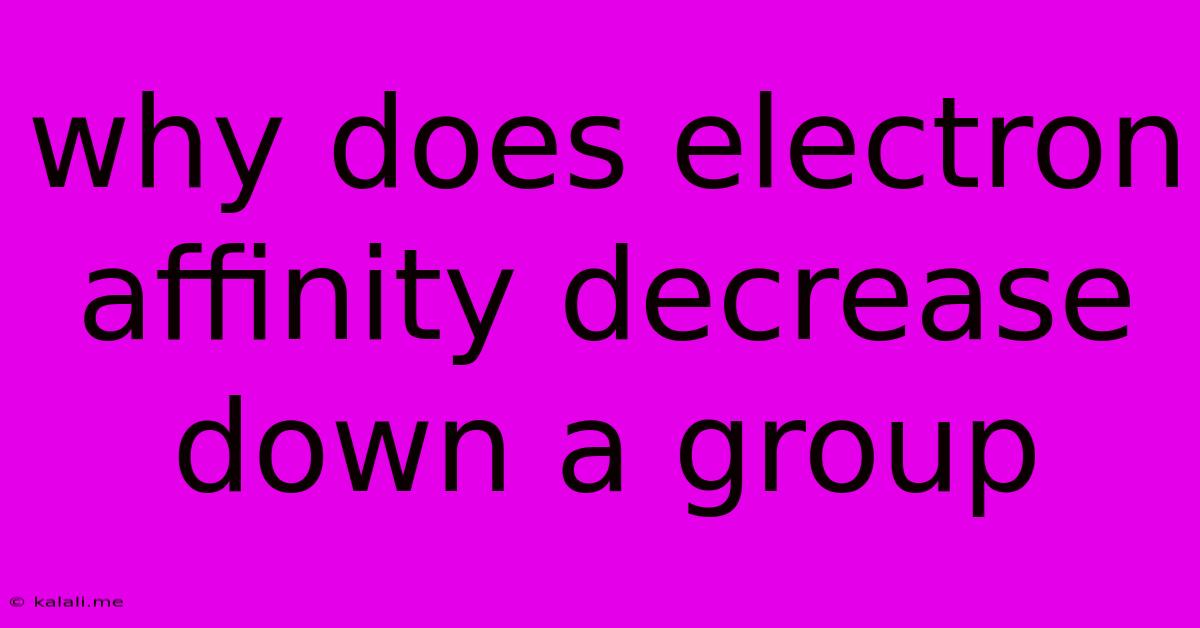Why Does Electron Affinity Decrease Down A Group
Kalali
May 09, 2025 · 3 min read

Table of Contents
Why Does Electron Affinity Decrease Down a Group? Understanding the Trend in Periodic Properties
Electron affinity, the energy change when an atom gains an electron, is a crucial periodic property that influences an element's chemical behavior. While it generally increases across a period, a fascinating trend emerges down a group: electron affinity generally decreases. This article delves into the reasons behind this decrease, explaining the interplay of atomic size and electron shielding.
Understanding this trend is vital for predicting the reactivity of elements and their ability to form stable compounds. This article will explore the key factors influencing electron affinity and provide a clear explanation for the observed downward trend within groups in the periodic table. We will examine the role of distance from the nucleus and the shielding effect of inner electrons.
The Role of Atomic Size
As you move down a group in the periodic table, the atomic size increases significantly. This is due to the addition of electron shells, which increases the distance between the nucleus and the outermost electrons (valence electrons). The added electron shells also mean that the valence electrons are further away from the positively charged nucleus.
Shielding Effect: Weakening the Nuclear Attraction
The increase in atomic size is directly linked to the shielding effect. Inner electrons shield the valence electrons from the full positive charge of the nucleus. As you move down a group, the number of inner electrons increases significantly. This increased shielding effect reduces the attractive force experienced by the incoming electron. The valence electrons are less strongly attracted to the nucleus because they are further away and shielded by many inner electrons.
Decreased Effective Nuclear Charge
The combination of increased distance and enhanced shielding leads to a decrease in the effective nuclear charge. The effective nuclear charge is the net positive charge experienced by the valence electrons. A lower effective nuclear charge means the nucleus exerts a weaker pull on the incoming electron, resulting in a lower electron affinity.
Exceptions to the Trend
It's important to note that while electron affinity generally decreases down a group, there are exceptions to this trend. These exceptions are often due to subtle variations in electron configurations and other electronic factors. For example, the electron affinity of some elements might be slightly higher or lower than expected based solely on atomic size and shielding. These exceptions often require a deeper analysis of the specific electronic structure of the atom involved. However, the overall trend of decreasing electron affinity down a group remains a strong and predictable observation.
In Summary
The decrease in electron affinity down a group primarily stems from the increasing atomic size and the consequential increase in the shielding effect. These factors reduce the effective nuclear charge, leading to a weaker attraction for an additional electron. This explains why elements lower down in a group are generally less likely to readily gain an electron than those higher up. Understanding this fundamental principle is critical for comprehending the chemical behavior and reactivity of elements.
Latest Posts
Latest Posts
-
What Is 450 Degrees Fahrenheit In Centigrade
May 09, 2025
-
27 Rounded To The Nearest Ten
May 09, 2025
-
What Percentage Is 50 Of 1000
May 09, 2025
-
How Much Is 64 Fluid Oz
May 09, 2025
-
Which Quadrilaterals Always Have Diagonals That Bisect Opposite Angles
May 09, 2025
Related Post
Thank you for visiting our website which covers about Why Does Electron Affinity Decrease Down A Group . We hope the information provided has been useful to you. Feel free to contact us if you have any questions or need further assistance. See you next time and don't miss to bookmark.